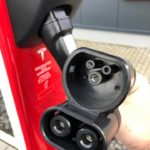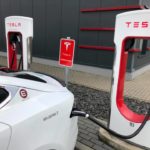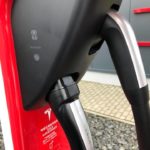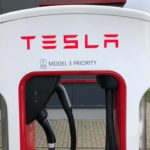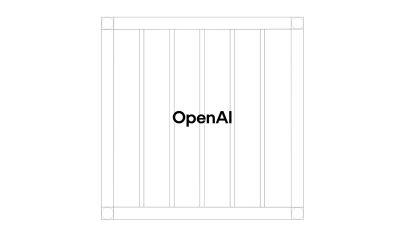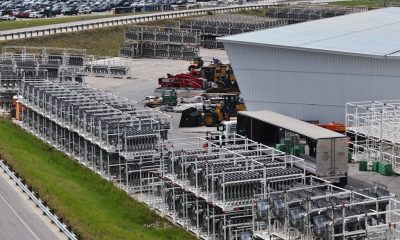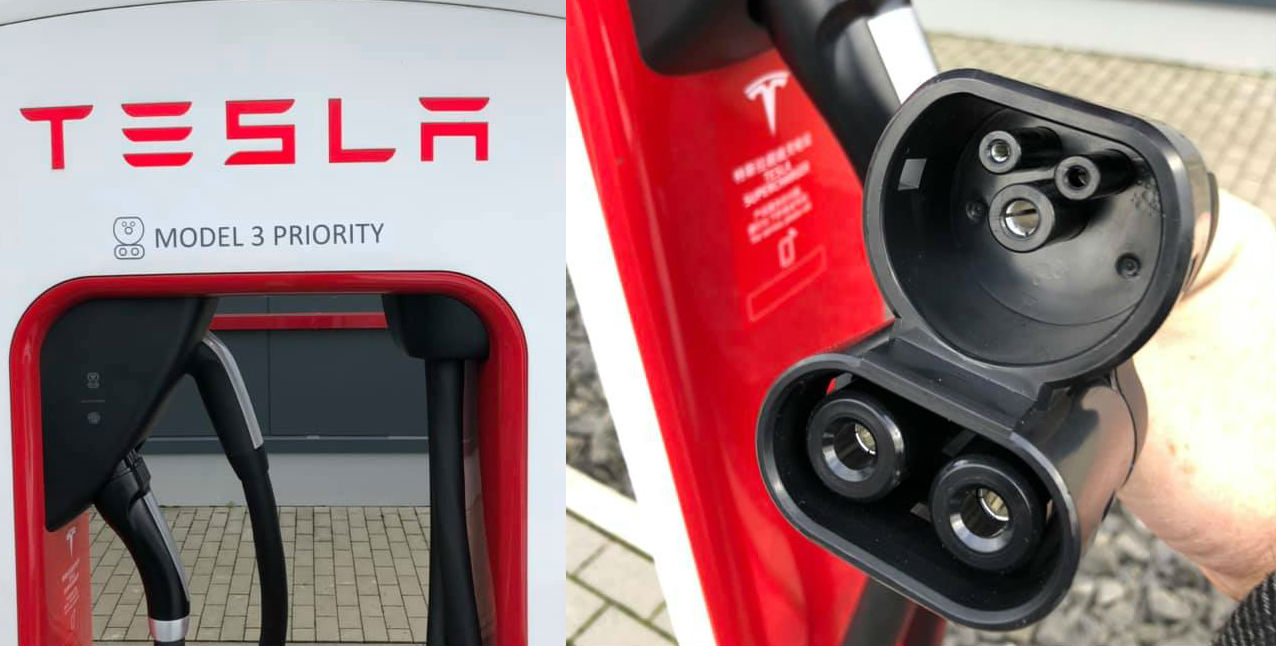

News
Tesla’s CCS Supercharger expansion ramps with dual-charge stall sightings in Europe
Tesla is yet to start deliveries of the Model 3 in Europe, but the electric car maker is already making the necessary preparations for the vehicle’s upcoming arrival. Across the region, for example, Tesla is expanding its CCS Supercharger Network, which is specifically designed to support the Model 3. Several members of the Tesla community across Europe have shared images of the dual charge stations being installed in multiple locations as well, further suggesting that Tesla’s CCS Supercharger ramp is well underway.
As noted by Tesla in a previous statement, the first dual charge CCS charging stalls were set up in the Badhoevedorp Supercharger near the Corendon Village Hotel, just outside Amsterdam last month. Tesla installed eight additional stalls on the site, each one equipped with both a Type 2 and CCS plug. The electric car maker noted that the CCS stalls are compatible with the Model S, 3, and X, though images of the chargers themselves list the stations as “Model 3 Priority.” Tesla further noted that the existing Supercharger Network in Europe would be retrofitted with the dual charge setup in the near future.
In true Tesla fashion, Tesla has not let up on its efforts to expand its CCS Superchargers in the region. Earlier this month, images of the first CCS-compatible Supercharger stall from Norway was shared on Reddit. Tesla owner enthusiast and longtime YouTube host Bjorn Nyland even featured the newly installed dual charge stations in one of his videos. In social media platforms, Tesla owners from Germany have also reported sightings of the newly-updated Superchargers being set up — an indication that Tesla is preparing for a massive influx of Model 3 in the region.
- (Photo: Klaus Schäfer/Facebook)
- (Photo: Klaus Schäfer/Facebook)
- (Photo: Klaus Schäfer/Facebook)
- (Photo: Klaus Schäfer/Facebook)
- (Photo: Klaus Schäfer/Facebook)
A dual charge CCS Supercharger listed as “Model 3 Priority” is spotted in Germany. (Photo: Klaus Schäfer/Facebook)
Unlike the Model S and Model X — both of which are fitted with a Type 2 port — the Model 3 is equipped with a CCS port. The company’s adoption of CCS stands as a significant step forward for the electric car maker, considering that the standard is prevalent in the region, being preferred by notable European automakers such as Volkswagen, BMW, and the Daimler group. CCS combines a Type 2 design, which is utilized for slower AC charging at home or work, as well as two DC pins at the bottom for fast charging. By adopting CCS for the Model 3, Tesla is all but laying the foundations for a massive charging infrastructure that employs one of the most popular standards in the region.
This, of course, presents some advantages for the electric car maker. Considering the wide reach of the Supercharger Network, Tesla could open the doors to its charging infrastructure to other automakers, providing itself with a potentially lucrative source of revenue. This was something that was referenced by Tesla Head of Global Charging Infrastructure Drew Bennett in an interview with Auto Express UK, when he noted that several electric car companies have already reached out to Tesla about the idea of using the Supercharger Network.
“We’re definitely open to talking to other car manufacturers who want to have access to the network. Capacity is a driver for our investment; it’s new routes, new markets and then capacity. A lot of car makers have spoken to us about it, but we haven’t had any conclusive discussions on it. They’re still trying to figure out what they would need in a network, but we’re a couple of years ahead of them in terms of embracing the investment required to transition to EVs,” he said.
As Tesla’s CCS Supercharger ramp continues, thousands of Model 3 are already being shipped to Europe from the United States. Local news reports suggest that Tesla is aiming to ship 3,000 of the vehicles every week for the region. For now, though, there is practically nothing that could stand in the way of the Model 3’s eventual saturation of the European market, especially considering that regulators recently granted homologation approval for the electric sedan.
Watch Bjorn Nyland’s video on Tesla’s CCS Superchargers in the video below.
News
These Tesla, X, and xAI engineers were just poached by OpenAI
The news is the latest in an ongoing feud between Elon Musk and the Sam Altman-run firm OpenAI.

OpenAI, the xAI competitor for which Elon Musk previously served as a boardmember and helped to co-found, has reportedly poached high-level engineers from Tesla, along with others from xAI, X, and still others.
On Tuesday, Wired reported that OpenAI hired four high-level engineers from Tesla, xAI, and X, as seen in an internal Slack message sent by co-founder Greg Brockman. The engineers include Tesla Vice President of Software Engineering David Lau, X and xAI’s head of infrastructure engineering Uday Ruddarraju, and fellow xAI infrastructure engineer Mike Dalton. The hiring spree also included Angela Fan, an AI researcher from Meta.
“We’re excited to welcome these new members to our scaling team,” said Hannah Wong, an OpenAI spokesperson. “Our approach is to continue building and bringing together world-class infrastructure, research, and product teams to accelerate our mission and deliver the benefits of AI to hundreds of millions of people.”
Lau has been in his position as Tesla’s VP of Software Engineering since 2017, after previously working for the company’s firmware, platforms, and system integration divisions.
“It has become incredibly clear to me that accelerating progress towards safe, well-aligned artificial general intelligence is the most rewarding mission I could imagine for the next chapter of my career,” Lau said in a statement to Wired.
🚨Optimistic projections point to xAI possibly attaining profitability by 2027, according to Bloomberg's sources.
If accurate, this would be quite a feat for xAI. OpenAI, its biggest rival, is still looking at 2029 as the year it could become cash flow positive.💰 https://t.co/pE5Z9daez8
— TESLARATI (@Teslarati) June 18, 2025
READ MORE ON OPENAI: Elon Musk’s OpenAI lawsuit clears hurdle as trial looms
At xAI, Ruddarraju and Dalton both played a large role in developing the Colossus supercomputer, which is comprised of over 200,000 GPUs. One of the major ongoing projects at OpenAI is the company’s Stargate program,
“Infrastructure is where research meets reality, and OpenAI has already demonstrated this successfully,” Ruddarraju told Wired in another statement. “Stargate, in particular, is an infrastructure moonshot that perfectly matches the ambitious, systems-level challenges I love taking on.”
Elon Musk is currently in the process of suing OpenAI for shifting toward a for-profit model, as well as for accepting an investment of billions of dollars from Microsoft. OpenAI retaliated with a counterlawsuit, in which it alleges that Musk is interfering with the company’s business and engaging in unfair competition practices.
Elon Musk confirms Grok 4 launch on July 9 with livestream event
News
SpaceX share sale expected to back $400 billion valuation
The new SpaceX valuation would represent yet another record-high as far as privately-held companies in the U.S. go.

A new report this week suggests that Elon Musk-led rocket company SpaceX is considering an insider share sale that would value the company at $400 billion.
SpaceX is set to launch a primary fundraising round and sell a small number of new shares to investors, according to the report from Bloomberg, which cited people familiar with the matter who asked to remain anonymous due to the information not yet being public. Additionally, the company would sell shares from employees and early investors in a follow-up round, while the primary round would determine the price for the secondary round.
The valuation would represent the largest in history from a privately-owned company in the U.S., surpassing SpaceX’s previous record of $350 billion after a share buyback in December. Rivaling company valuations include ByteDance, the parent company of TikTok, as well as OpenAI.
Bloomberg went on to say that a SpaceX representative didn’t respond to a request for comment at the time of publishing. The publication also notes that the details of such a deal could still change, especially depending on interest from the insider sellers and share buyers.
Axiom’s Ax-4 astronauts arriving to the ISS! https://t.co/WQtTODaYfj
— TESLARATI (@Teslarati) June 26, 2025
READ MORE ON SPACEX: SpaceX to decommission Dragon spacecraft in response to Pres. Trump war of words with Elon Musk
SpaceX’s valuation comes from a few different key factors, especially including the continued expansion of the company’s Starlink satellite internet company. According to the report, Starlink accounts for over half of the company’s yearly revenue. Meanwhile, the company produced its 10 millionth Starlink kit last month.
The company also continues to develop its Starship reusable rocket program, despite the company experiencing an explosion of the rocket on the test stand in Texas last month.
The company has also launched payloads for a number of companies and government contracts. In recent weeks, SpaceX launched Axiom’s Ax-4 mission, sending four astronauts to the International Space Station (ISS) for a 14-day stay to work on around 60 scientific experiments. The mission was launched using the SpaceX Falcon 9 rocket and a new Crew Dragon capsule, while the research is expected to span a range of fields including biology, material and physical sciences, and demonstrations of specialized technology.
News
Tesla Giga Texas continues to pile up with Cybercab castings
Tesla sure is gathering a lot of Cybercab components around the Giga Texas complex.

Tesla may be extremely tight-lipped about the new affordable models that it was expected to start producing in the first half of the year, but the company sure is gathering a lot of Cybercab castings around the Giga Texas complex. This is, at least, as per recent images taken of the facility.
Cybercab castings galore
As per longtime drone operator Joe Tegtmeyer, who has been chronicling the developments around the Giga Texas complex for several years now, the electric vehicle maker seems to be gathering hundreds of Cybercab castings around the factory.
Based on observations from industry watchers, the drone operator appears to have captured images of about 180 front and 180 rear Cybercab castings in his recent photos.
Considering the number of castings that were spotted around Giga Texas, it would appear that Tesla may indeed be preparing for the vehicle’s start of trial production sometime later this year. Interestingly enough, large numbers of Cybercab castings have been spotted around the Giga Texas complex in the past few months.
Cybercab production
The Cybercab is expected to be Tesla’s first vehicle that will adopt the company’s “unboxed” process. As per Tesla’s previous update letters, volume production of the Cybercab should start in 2026. So far, prototypes of the Cybercab have been spotted testing around Giga Texas, and expectations are high that the vehicle’s initial trial production should start this year.
With the start of Tesla’s dedicated Robotaxi service around Austin, it might only be a matter of time before the Cybercab starts being tested on public roads as well. When this happens, it would be very difficult to deny the fact that Tesla really does have a safe, working autonomous driving system, and it has the perfect vehicle for it, too.
-

 Elon Musk1 week ago
Elon Musk1 week agoTesla investors will be shocked by Jim Cramer’s latest assessment
-

 News2 weeks ago
News2 weeks agoTesla Robotaxi’s biggest challenge seems to be this one thing
-

 Elon Musk1 day ago
Elon Musk1 day agoElon Musk confirms Grok 4 launch on July 9 with livestream event
-

 News2 weeks ago
News2 weeks agoWatch the first true Tesla Robotaxi intervention by safety monitor
-

 News5 days ago
News5 days agoTesla Model 3 ranks as the safest new car in Europe for 2025, per Euro NCAP tests
-

 Elon Musk2 weeks ago
Elon Musk2 weeks agoA Tesla just delivered itself to a customer autonomously, Elon Musk confirms
-

 Elon Musk2 weeks ago
Elon Musk2 weeks agoxAI welcomes Memphis pollution results, environmental groups push back
-

 Elon Musk2 weeks ago
Elon Musk2 weeks agoElon Musk confirms Tesla Optimus V3 already uses Grok voice AI

